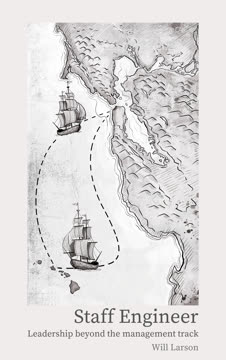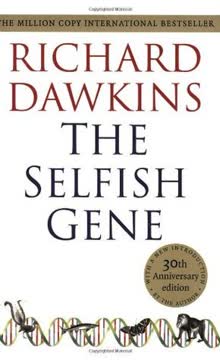Key Takeaways
1. Cooperation emerges through reciprocity, even among egoists
The problem is that while an individual can benefit from mutual cooperation, each one can also do even better by exploiting the cooperative efforts of others.
The Prisoner's Dilemma. This game-theoretic model captures the essence of cooperation's challenge. Two players must choose to either cooperate or defect, with payoffs structured so that:
- Mutual cooperation is better than mutual defection
- Unilateral defection yields the highest individual payoff
- Being exploited (cooperating while the other defects) yields the lowest payoff
Iterated interactions change everything. When players face each other repeatedly:
- The future casts a shadow on present decisions
- Strategies can emerge that reward cooperation and punish defection
- Reciprocity becomes a viable and powerful approach
Egoists can cooperate. Contrary to intuition, self-interested individuals can develop cooperative relationships when:
- Interactions are likely to be repeated
- Players can recognize and remember past behavior
- The benefits of long-term cooperation outweigh short-term exploitation
2. TIT FOR TAT: A simple yet powerful strategy for cooperation
TIT FOR TAT's robust success is due to being nice, provocable, forgiving, and clear.
Anatomy of TIT FOR TAT:
- Cooperate on the first move
- Then do whatever the other player did on the previous move
Key strengths:
- Nice: Never the first to defect
- Provocable: Responds immediately to defection
- Forgiving: Returns to cooperation after a single retaliatory defection
- Clear: Easy for others to recognize and understand
Tournament champion. TIT FOR TAT won Axelrod's famous computer tournaments, outperforming more complex strategies. Its success stems from:
- Eliciting cooperation from a wide range of strategies
- Protecting itself from exploitation
- Performing well with both "nice" and "mean" strategies
- Clarity allowing other players to adapt and cooperate
3. The shadow of the future enables cooperative behavior
What makes it possible for cooperation to emerge is the fact that the players might meet again.
Future interactions matter. The likelihood of future encounters creates incentives for cooperation by:
- Making the long-term benefits of cooperation outweigh short-term gains from defection
- Allowing for the possibility of retaliation or reward based on current behavior
Discount parameter (w). This factor represents the importance of the next move relative to the current one, influenced by:
- Probability of future interaction
- Value placed on future payoffs
Cooperation becomes stable when w is sufficiently high. For TIT FOR TAT to be collectively stable:
w ≥ max[(T-R)/(T-P), (T-R)/(R-S)]
Where T = Temptation, R = Reward, P = Punishment, S = Sucker's payoff
Real-world implications:
- Long-term relationships foster cooperation
- Uncertainty about future interactions can hinder cooperation
- Institutions can promote cooperation by increasing the shadow of the future
4. Cooperation can thrive in a world of defectors through clustering
Even a small cluster of individuals using a strategy based on reciprocity can invade a population of meanies.
The power of clusters. A group of cooperators can establish themselves in a sea of defectors if:
- They interact with each other more frequently than with the general population
- Their strategy performs well when interacting with itself
Numerical example:
- Environment: 90% interactions with ALL D players, 10% with other cluster members
- Cluster strategy: TIT FOR TAT
- Result: TIT FOR TAT players outperform ALL D, even with minimal clustering
Implications:
- Cooperation can emerge from small pockets of reciprocators
- Social structures that promote clustering (e.g., neighborhoods, professional associations) can foster cooperation
- Innovative cooperators don't need to convert everyone at once to succeed
5. Nice strategies prosper but must be provokable to be stable
To be effective, a strategy must be able at any point to take into account the history of the interaction as it has developed so far.
Characteristics of successful strategies:
- Nice: Never the first to defect
- Retaliatory: Respond to defection to avoid exploitation
- Forgiving: Ability to restore cooperation after conflict
- Clear: Easily understood by other players
The importance of provocability:
- Prevents exploitation by defectors
- Teaches other players that defection will be punished
- Maintains the stability of cooperative relationships
Balance is key:
- Too much retaliation can lead to unnecessary conflict
- Too little can invite exploitation
- Successful strategies find the right balance (e.g., TIT FOR TAT's one-for-one approach)
6. Cooperation evolves gradually: From chaos to reciprocity
The evolutionary process allows the successful strategies to thrive, even if the players do not know why or how.
Stages of cooperative evolution:
- Initial chaos: Diverse strategies compete
- Elimination of poor performers: Clearly inferior strategies die out
- Rise of reciprocators: Strategies based on reciprocity gain ground
- Stability: Cooperative norms become established
Mechanisms of evolution:
- Natural selection: Successful strategies reproduce more frequently
- Learning and imitation: Players adopt strategies that seem to work well
- Trial and error: New variations are constantly introduced and tested
Key insights:
- Cooperation can emerge without conscious design or central authority
- The process is gradual and builds upon itself
- Once established, cooperation based on reciprocity is robust and self-reinforcing
7. Promoting cooperation: Enlarge the future and change payoffs
To promote cooperation through modification of the payoffs, it is not necessary to go so far as to eliminate the tension between the short-run incentive to defect and the longer-run incentive to achieve mutual cooperation.
Enlarge the shadow of the future:
- Increase the frequency of interactions
- Extend the duration of relationships
- Make future interactions more certain
Modify payoffs:
- Increase rewards for mutual cooperation (R)
- Decrease temptation for unilateral defection (T)
- Increase punishment for mutual defection (P)
- Government policies and social norms can serve this function
Additional strategies:
- Foster clear communication between parties
- Promote transparency in actions and outcomes
- Develop institutions that support long-term relationships
- Educate about the benefits of cooperation and reciprocity
8. The power of recognition and reputation in fostering cooperation
The expanded ability to recognize individuals with whom one has already interacted allows humans to develop a much richer set of cooperative relationships than birds can.
Recognition capabilities:
- Bacteria: Limited to exclusive relationships
- Birds: Can distinguish several neighbors
- Humans: Specialized brain regions for face recognition
Reputation effects:
- Past behavior influences future interactions
- Reputations can spread beyond direct interactions
- Incentivizes cooperation even in one-time encounters
Strategic implications:
- Players may act to build a cooperative reputation
- Reputation for toughness can deter exploitation
- Clarity in strategy helps establish a reliable reputation
9. Cooperation without central authority: Self-policing strategies
What gives TIT FOR TAT its slightly unsavory taste is its insistence on an eye for an eye. This is rough justice indeed. But the real issue is whether there are any better alternatives.
Self-policing mechanisms:
- Reciprocity-based strategies punish defectors
- Cooperative players prosper, defectors struggle
- No central authority needed to enforce cooperation
Advantages:
- Scalable to large, decentralized systems
- Adaptable to changing environments
- Resilient against attempts to game the system
Challenges:
- Can lead to prolonged conflicts (e.g., blood feuds)
- May seem unfair or harsh in some contexts
- Requires players to have sufficient information and memory
10. Territoriality and social structure shape cooperative dynamics
The gear wheels of social evolution have a ratchet.
Territorial effects:
- Frequent interactions with neighbors promote cooperation
- Successful strategies can spread geographically
- Spatial structures can protect cooperators from invasion
Social structures influence cooperation:
- Hierarchies can concentrate interactions, fostering cooperation
- Networks determine who interacts with whom
- Labels and stereotypes can create in-group/out-group dynamics
Evolutionary implications:
- Cooperation, once established, is difficult to displace
- Social structures can accelerate or impede the evolution of cooperation
- Understanding these dynamics can help design better institutions and policies
Last updated:
FAQ
What's The Evolution of Cooperation about?
- Exploration of cooperation dynamics: The book examines how cooperation can arise among self-interested individuals without a central authority, using the iterated Prisoner’s Dilemma as a framework.
- Computer tournaments as a method: Robert Axelrod conducted computer tournaments to test various strategies, finding that simple strategies like TIT FOR TAT were highly effective.
- Implications for various fields: The findings have applications in political science, economics, sociology, and biology, showing how cooperation can be fostered in diverse contexts.
Why should I read The Evolution of Cooperation?
- Insight into human behavior: It provides a deep understanding of the conditions under which cooperation can thrive, essential for navigating social, political, and economic relationships.
- Practical applications: Axelrod’s insights can be applied to real-world situations, from international relations to personal interactions, making it relevant for anyone interested in improving cooperation.
- Foundational theories: The book lays the groundwork for understanding cooperation in both human and biological systems, contributing significantly to social science literature.
What are the key takeaways of The Evolution of Cooperation?
- Importance of reciprocity: Cooperation is most likely to emerge when individuals can reciprocate actions, as shown by the success of the TIT FOR TAT strategy.
- Conditions for cooperation: Cooperation can develop even in non-cooperative environments if there are clusters of individuals willing to cooperate, highlighting the role of social structures.
- Long-term interactions matter: The likelihood of future interactions is crucial for sustaining cooperation, influencing individuals' decisions to cooperate or defect.
What is the TIT FOR TAT strategy in The Evolution of Cooperation?
- Simple and effective: TIT FOR TAT starts with cooperation and mimics the other player's previous move, making it a straightforward yet powerful strategy.
- Winning in tournaments: This strategy won both rounds of Axelrod's computer tournaments, demonstrating its robustness against various competing strategies.
- Characteristics of success: It is nice (never defects first), retaliatory (defects after a defection), and forgiving (returns to cooperation after a single defection).
How does Axelrod define cooperation in The Evolution of Cooperation?
- Mutual benefit focus: Cooperation involves actions that benefit both parties, contrasting with purely selfish behavior.
- Iterated Prisoner’s Dilemma framework: The book uses this model to illustrate how cooperation can emerge and be sustained over time through reciprocal actions.
- Strategic interactions: Cooperation is a strategic choice that can lead to better outcomes when individuals recognize the potential for future interactions.
What are the implications of the Prisoner’s Dilemma in The Evolution of Cooperation?
- Understanding conflict and cooperation: The Prisoner’s Dilemma shows the tension between individual rationality and collective benefit, illustrating how self-interested actions can lead to suboptimal outcomes.
- Real-world applications: The model applies to scenarios like international relations and business negotiations, where cooperation is beneficial but difficult to achieve.
- Framework for analysis: Axelrod uses the Prisoner’s Dilemma to analyze the conditions necessary for cooperation, providing a theoretical basis for understanding complex social dynamics.
How does the concept of the "shadow of the future" influence cooperation in The Evolution of Cooperation?
- Future interactions matter: The shadow of the future refers to the importance of anticipated future encounters in determining current behavior.
- Impact on decision-making: A strong shadow of the future increases the incentive to cooperate, as the potential for future retaliation or reward becomes significant.
- Examples in real life: Historical examples, like trench warfare in WWI, illustrate how prolonged interactions can lead to cooperative norms.
What role does the concept of "nice" strategies play in The Evolution of Cooperation?
- Definition of "nice" strategies: Nice strategies do not defect first and are willing to cooperate, crucial for fostering mutual cooperation.
- Performance in tournaments: The success of nice strategies, particularly TIT FOR TAT, highlights their effectiveness in promoting cooperation over time.
- Resistance to invasion: Nice strategies can resist invasion by less cooperative strategies, creating an environment where mutual cooperation is more rewarding.
How does Axelrod address the sustainability of cooperation in The Evolution of Cooperation?
- Conditions for stability: Cooperation is sustainable when individuals have a high probability of future interactions, allowing them to benefit from mutual cooperation.
- Role of retaliation: The ability to retaliate against defections is essential for maintaining cooperation, discouraging exploitation and encouraging reciprocal behavior.
- Long-term relationships: Stable cooperation often arises in contexts where individuals interact repeatedly, allowing for the establishment of trust and reciprocity.
What are the historical examples used in The Evolution of Cooperation?
- Trench warfare in WWI: Axelrod discusses the "live-and-let-live" system among soldiers, illustrating how cooperation can develop even in adversarial contexts.
- Biological systems: The book explores cooperation in nature, such as mutualism between species, showing that cooperation can evolve without foresight or friendship.
- Real-world applications: These examples illustrate the principles of cooperation and reciprocity in action, reinforcing the theoretical concepts presented.
What advice does Axelrod offer for fostering cooperation in The Evolution of Cooperation?
- Encourage reciprocity: Practice reciprocity in interactions to build trust and encourage cooperative behavior over time.
- Avoid envy and competition: Focus on mutual benefits rather than comparing scores with others to maintain a cooperative atmosphere.
- Be forgiving: Willingness to forgive past defections and return to cooperation is crucial for sustaining long-term relationships.
What are the best quotes from The Evolution of Cooperation and what do they mean?
- Dynamic interactions: "The heart of the problem was that these maximizing rules did not take into account that their own behavior would lead the other player to change."
- Simplicity over complexity: "It does not pay to be clever in modeling the other player if you leave out the reverberating process."
- Encouraging cooperation: "The trick is to encourage that cooperation," emphasizing the need for strategies that promote mutual benefits.
Review Summary
The Evolution of Cooperation explores how cooperation emerges in various contexts using game theory and the Prisoner's Dilemma. Axelrod's research demonstrates that the Tit-for-Tat strategy—being nice, retaliatory, forgiving, and clear—is highly successful in promoting cooperation. The book examines real-world applications, including trench warfare in World War I and biological evolution. Readers praise its insightful analysis and relevance to understanding human behavior, though some find the writing style repetitive. Overall, it's considered a seminal work in game theory with implications for personal relationships, business, and international relations.
Similar Books








Download PDF
Download EPUB
.epub digital book format is ideal for reading ebooks on phones, tablets, and e-readers.





